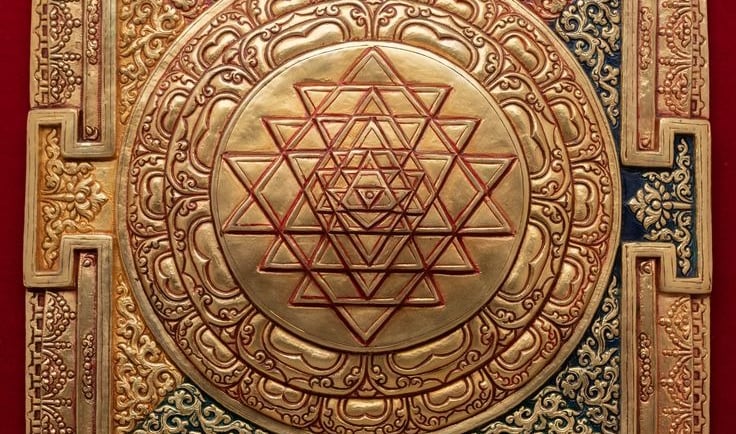Shri yantra- King of yantras
Shri Yantra transcends the boundaries of faith and enters the realm of universal truths. Its intricate structure and profound symbolism have intrigued believers and non-believers alike, making it a fascinating subject to explore.
RELIGION
1/25/20253 min read


Shri Yantra: Unveiling Its Origins, Symbolism, and Relevance in Modern Times
The Shri Yantra, often referred to as the "King of Yantras," is a geometric diagram of immense spiritual and scientific significance. Found at the crossroads of Hindu philosophy, sacred geometry, and metaphysics, the Shri Yantra transcends the boundaries of faith and enters the realm of universal truths. Its intricate structure and profound symbolism have intrigued believers and non-believers alike, making it a fascinating subject to explore.
Origins of the Shri Yantra: A Timeless Mystery
The origins of the Shri Yantra trace back to ancient India, deeply rooted in the Vedic traditions. It is widely associated with Shakti worship, the divine feminine energy in Hinduism. References to the Shri Yantra can be found in Hindu scriptures like the Rigveda, the Lalita Sahasranama, and the Devi Bhagavata Purana. These texts describe the Shri Yantra as the embodiment of cosmic energy and the structure of the universe.
Who Created the Shri Yantra?
The creation of the Shri Yantra is attributed to divine revelation rather than human ingenuity. It is believed that ancient sages or "rishis" received the design through meditation and deep connection with the cosmos. Adi Shankaracharya, the great 8th-century philosopher, is credited with popularizing the Shri Yantra in its modern form. He explained its spiritual and metaphysical significance in his commentary on the Soundarya Lahari, a poetic text dedicated to the goddess Lalita Tripurasundari.
Structure and Symbolism
The Shri Yantra consists of nine interlocking triangles arranged in a precise geometric pattern. These triangles radiate from a central point, known as the bindu, representing the origin of creation.
Upward-facing triangles symbolize Shiva (masculine energy).
Downward-facing triangles symbolize Shakti (feminine energy).
Together, they form 43 smaller triangles, representing the cosmos and the human body.
Surrounding the triangles are concentric circles and lotus petals, symbolizing the cyclical nature of life and spiritual awakening.
This sacred geometry is not random; it is based on mathematical precision and symmetry, reflecting the harmony of the universe.
Scientific Relevance of the Shri Yantra
The Shri Yantra is more than a religious symbol; it is a manifestation of sacred geometry that aligns with modern science.
Golden Ratio: The proportions of the Shri Yantra align with the golden ratio (1:1.618), a mathematical constant found in nature, art, and architecture. This ratio is associated with beauty, balance, and harmony.
Energy Resonance: Studies suggest that meditating on the Shri Yantra enhances focus and mental clarity. The geometric design is believed to create a resonance field that positively influences the mind and body.
Vastu Shastra: The Shri Yantra is often used in architectural designs for creating harmonious living spaces. It is believed to balance the energies of a place and bring prosperity.
Religious Significance
In Hinduism, the Shri Yantra is revered as a representation of Goddess Lalita Tripurasundari, the supreme deity of beauty and power. Worshiping the Shri Yantra is believed to:
Remove obstacles and negative energies.
Bring prosperity, health, and spiritual enlightenment.
Enhance one’s connection with the divine cosmic energy.
The practice of Sri Vidya Upasana, a form of tantric worship, revolves around the Shri Yantra. It is not merely an object of devotion but a tool for spiritual growth and self-realization.
Appealing to Non-Believers: Beyond Faith
For those skeptical of religious symbolism, the Shri Yantra offers insights into universal truths. Its design embodies principles of order, balance, and interconnectedness, concepts that resonate beyond spiritual beliefs. Even Carl Jung, the renowned psychologist, studied mandalas and yantras, recognizing them as tools for psychological integration and self-discovery.
Additionally, the Shri Yantra’s alignment with scientific principles like geometry, energy fields, and human psychology makes it a subject of interdisciplinary interest. Meditating on the Shri Yantra can be approached as a mindfulness exercise, fostering mental clarity and emotional well-being.
Modern Relevance
In today’s fast-paced world, the Shri Yantra serves as a reminder of the need for harmony and balance. Whether placed in homes, offices, or meditation spaces, it continues to inspire seekers of truth, irrespective of their faith or background.
Conclusion
The Shri Yantra is more than an artifact of Hindu culture; it is a universal symbol of cosmic harmony and human potential. Its intricate design, spiritual depth, and scientific relevance make it an object of admiration for believers and skeptics alike. As humanity seeks answers to life’s biggest questions, the Shri Yantra stands as a timeless guide, urging us to look within and align with the cosmos.
By understanding its origins, symbolism, and relevance, we can appreciate the Shri Yantra not just as a religious emblem but as a profound representation of universal truths.